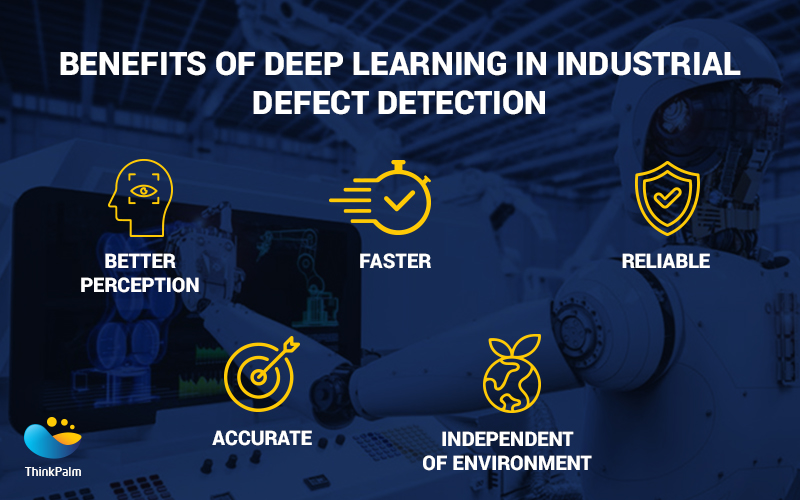The need for quality control is quintessential in several manufacturing processes, especially those involving large-scale production on a daily basis. However, manual quality control procedures for such large-scale manufacturing industries are often time-consuming and error-prone. In order to meet the growing demand for high-quality products, the use of artificially intelligent systems is becoming imperative in production lines.
Since quality management is one of the most integral functions in a manufacturing process, industries are striving to leverage the most beneficial technology for fault detection. With the change in growth targets along with the increase in product demands across the globe, manufacturers are forced to increase their production rate while ensuring stringent quality measures are taken. Therefore, in order to meet the growing demand for high-quality products, the implementation of Artificial Intelligence (AI) and Deep Learning is fundamental in the manufacturing sector.
The manufacturing process of both large-scale sectors such as the automobile industry to small-scale sectors such as device or router manufacturing is vulnerable to defects. These defects could be very minute or microscopic flaws but are capable of determining the final product quality. If not properly identified this can result in a mass recall of products that could significantly alter the brand reputation and cause millions of dollars in losses. Not only for the product manufacturers, but the defective product can also affect the buyers as well, resulting in a catastrophic accident. For instance, If a nuclear industry purchases these undetected defective items, it can lead to fatal and devastating outcomes for employees as well as the environment. Therefore, early detection of defects in the manufacturing process itself is crucial and life-saving. Every industry must invest in the latest technologies such as Artificial Intelligence, Image Detection, Thermal Scanners, Sensors, IoT devices, etc to facilitate consistent and cost-effective inspection. 
Industries are looking to eliminate time-consuming and risky traditional practices across multiple domains. With the emergence of Industry 4.0, several organizations started focusing on automating their usual operations. Everything from product development to test automation services and deployment was automated. The inclusion of automated technologies enhanced the production floor and assisted employees in reducing tedious or monotonous tasks. Similarly, with the implementation of visual inspection systems based on imaging, sensors, and infrared, industries were able to perform faster inspection rates, deliver higher quality solutions, and significantly reduced product inefficiencies through quantitative evaluation.
Over the years deep-learning technology has developed rapidly. It has created exceptional possibilities in object detection, intelligent automation, error identification, autonomous driving, and other fields. Deep learning has a kind of deep neural network structure with recurring convolutions layers. This connects low-level features to form a more abstract high-level representation of attribute categories or features. Therefore, several industries have already integrated deep-learning technology to defect detection of products and enhance product quality.
With Deep learning, industries can make use of non-destructive inspection techniques. These techniques can be used on even the smallest product and ensure that the product undergoes no changes during the inspection. In other words, it enables a product to be examined during the manufacturing process itself without risking the quality of the product.
There are several nondestructive inspection techniques available for producing two-dimensional and three-dimensional images of an object. Unlike image scanning to detect defection, deep learning can leverage multiple imaging technologies to ensure the product is 100% non-defective.
Deep learning allows for increased versatility as it can easily understand the variations in positioning, orientation, illumination and background textures. This is extremely difficult to do with traditional automated techniques. Deep learning can also outperform manual or traditional defect identification strategies with 100% reliable results. Industries that are capable of integrating a well-designed defect detection model can deliver faster, more accurate results and high-quality products to clients. Deep learning models are highly scalable and adaptable, which makes it easier for industries to integrate them at more stages of production, allowing defective parts to be rejected early in the manufacturing process. This method of detecting defects earlier in the product life cycle is a large cost-saver because it stops a defective product from undergoing needless value-adding processes in the supply chain.

Here are some other benefits of deep learning in industrial defect detection
The deep learning-based machine vision has a very high optical resolution which also depends upon the high-end technology and devices used for image acquisition. Compared to human apprehension, machine vision has a more advanced spectrum of optical perception with the expertise to conduct inspections in the Ultraviolet, XRay and Infrared regions of the spectrum as well.
Inspections, as well as report generation, are made extremely fast with the help of deep learning. The observation system used for defect detection has all the power associated with higher processing speeds along with possibly infinite memory storage.
Not only the detection results but the entire identification system is reliable. It is capable of identifying product internal and external errors following the input instructions without swaying away from any code.
An automated system is capable of following the manufacturing protocols and can ensure that all compliances and industry standards are accurately met. It ensures not only that the product is defect-free but also checks if the size, measure, and dimensions are in a standardized manner.
A deep learning architecture can be deployed in dangerous and hazardous conditions such as nuclear reactors where manual detection is almost impossible to perform and too risky.
Our object detection solution makes computer vision and deep learning more accessible. It simplifies the process of training, deploying, running and managing models. By leveraging the capabilities of image processing, artificial intelligence and deep learning, we can help clients efficiently and accurately inspect whether the industrial products have any type of manufacturing defects. Once the defect is identified, the model can be trained and customized with deep learning, so that similar defects can be easily identified. This intuitive solution is simple to operate, requires minimal operator training, and scales globally with the use of ubiquitous mobile hardware and Windows OS. ThinkPalm’s object detection solution is engineered to continuously improve accuracy with data management and training hardware. It ensures that clients utilize a scalable foundation for real-time computer vision quality inspection and identifies potential quality issues in real-time.